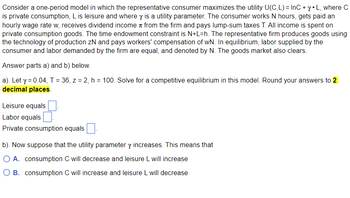
Microeconomic Theory
12th Edition
ISBN: 9781337517942
Author: NICHOLSON
Publisher: Cengage
expand_more
expand_more
format_list_bulleted
Question
Solve all this question......you will not solve all questions then I will give you down?? upvote...

Transcribed Image Text:Consider a one-period model in which the representative consumer maximizes the utility U(C,L) = InC + y •L, where C
is private consumption, L is leisure and where y is a utility parameter. The consumer works N hours, gets paid an
hourly wage rate w, receives dividend income from the firm and pays lump-sum taxes T. All income is spent on
private consumption goods. The time endowment constraint is N+L=h. The representative firm produces goods using
the technology of production ZN and pays workers' compensation of wN. In equilibrium, labor supplied by the
consumer and labor demanded by the firm are equal, and denoted by N. The goods market also clears.
Answer parts a) and b) below.
a). Let y = 0.04, T = 36, z = 2, h = 100. Solve for a competitive equilibrium in this model. Round your answers to 2
decimal places.
Leisure equals
Labor equals
Private consumption equals
b). Now suppose that the utility parameter y increases. This means that
A. consumption C will decrease and leisure L will increase
B. consumption C will increase and leisure L will decrease
Expert Solution
This question has been solved!
Explore an expertly crafted, step-by-step solution for a thorough understanding of key concepts.
Step by stepSolved in 4 steps with 1 images

Knowledge Booster
Learn more about
Need a deep-dive on the concept behind this application? Look no further. Learn more about this topic, economics and related others by exploring similar questions and additional content below.Recommended textbooks for you
 Macroeconomics: Principles and Policy (MindTap Co...EconomicsISBN:9781305280601Author:William J. Baumol, Alan S. BlinderPublisher:Cengage Learning
Macroeconomics: Principles and Policy (MindTap Co...EconomicsISBN:9781305280601Author:William J. Baumol, Alan S. BlinderPublisher:Cengage Learning Managerial Economics: Applications, Strategies an...EconomicsISBN:9781305506381Author:James R. McGuigan, R. Charles Moyer, Frederick H.deB. HarrisPublisher:Cengage Learning
Managerial Economics: Applications, Strategies an...EconomicsISBN:9781305506381Author:James R. McGuigan, R. Charles Moyer, Frederick H.deB. HarrisPublisher:Cengage Learning




Macroeconomics: Principles and Policy (MindTap Co...
Economics
ISBN:9781305280601
Author:William J. Baumol, Alan S. Blinder
Publisher:Cengage Learning

Managerial Economics: Applications, Strategies an...
Economics
ISBN:9781305506381
Author:James R. McGuigan, R. Charles Moyer, Frederick H.deB. Harris
Publisher:Cengage Learning


